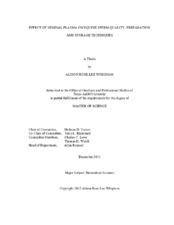| dc.description.abstract | This study had four experimental aims. We investigated whether fresh (unfrozen) or snap-frozen homologous seminal plasma yielded similar sperm quality in cool-stored semen. We compared sperm quality following exposure to homologous versus heterologous seminal plasma. Various freezing methods for long-term storage of seminal plasma were also tested to identify any impacts on longevity of sperm quality. Finally, we adapted a freeze-drying protocol originally developed for human blood plasma for use with stallion seminal plasma with the goal of comparing sperm quality in cooled-stored semen prepared with fresh, frozen/thawed or lyophilized seminal plasma. Prior to the lyophilization study, we evaluated different vials and rubber stoppers to identify the most appropriate storage container for this purpose. Experimental endpoints for sperm quality included percent total motility (TMOT), percent progressive motility (PMOT), curvilinear velocity (VCL; µm/s), straightness of track trajectory (([straight-line velocity/average-path velocity] x 100); %), percent viable (VIAB), percent acrosome intact (AI), and percentage of sperm with abnormal sperm DNA (COMP; %) Motility values were obtained using a computerized sperm motility analyzer, whereas values for VIAB, AI, and COMP were obtained using a flow cytometer.
No significant difference was detected between fresh and frozen/thawed seminal plasma for any experimental endpoint (P>0.05). Sperm from two of three stallions yielded similar values for sperm quality with homologous versus heterologous seminal plasma (P>0.05), whereas PMOT and STR in the remaining stallion were greater in heterologous seminal plasma, as compared to homologous seminal plasma (P<0.05). Various methods for processing and freezing seminal plasma prior to use resulted in only minor differences in sperm quality following cooled storage in extender. Prolonged exposure of sperm to chlorobutyl-isoprene blend rubber stoppers resulted in lower values for TMOT, PMOT, and VCL, as compared to chlorobutyl rubber stoppers or plastic vials (P<0.05); therefore, chlorobutyl stoppers were used in the lyophilization experiment. Lyophilization of seminal plasma resulted in similar values for TMOT, PMOT, VCL, VIAB, AI, and COMP, as compared to fresh or frozen/thawed seminal plasma (P>0.05). Variable STR was slightly lower with lyophilized seminal plasma, as compared to fresh or frozen/thawed seminal plasma (P<0.05). | en |


